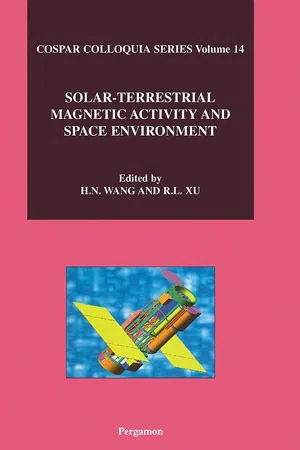
- 474 pages
- English
- ePUB (mobile friendly)
- Available on iOS & Android
About This Book
The COSPAR Colloquium on Solar-Terrestrial Magnetic Activity and Space Environment (STMASE) was held in the National Astronomy Observatories of Chinese Academy of Sciences (NAOC) in Beijing, China in September 10-12, 2001. The meeting was focused on five areas of the solar-terrestrial magnetic activity and space environment studies, including study on solar surface magnetism; solar magnetic activity, dynamical response of the heliosphere; space weather prediction; and space environment exploration and monitoring. A hot topic of space research, CMEs, which are widely believed to be the most important phenomenon of the space environment, is discussed in many papers. Other papers show results of observational and theoretical studies toward better understanding of the complicated image of the magnetic coupling between the Sun and the Earth, although little is still known little its physical background. Space weather prediction, which is very important for a modern society expanding into out-space, is another hot topic of space research. However, a long way is still to go to predict exactly when and where a disaster will happen in the space. In that sense, there is much to do for space environment exploration and monitoring. The manuscripts submitted to this Monograph are divided into the following parts: (1) solar surface magnetism, (2) solar magnetic activity, (3) dynamical response of the heliosphere, (4) space environment exploration and monitoring; and (5) space weather prediction. Papers presented in this meeting but not submitted to this Monograph are listed by title as unpublished papers at the end of this book.
Frequently asked questions
Information
Analysis of Lasco Observations of Streamer Blowout Events
2 Naval Research Laboratory, E. O. Hulburt Center for Space Research, Washington, DC 20375, USA
3 Physical Sciences Dept., Scottsdale Community College, Scottsdale, AZ 85256, USA
ABSTRACT
INTRODUCTION
| CME Type | Percent of total | Speed (km/s) | Span (deg) | Mass (1015 gr) | Kinetic Energy (1030 ergs) |
| Streamer Blowout | 5 | 200 | 44 | 5.4 | 0.56 |
| All | 100 | 472 | 45 | 4.1 | 3.5 |
Table of contents
- Cover image
- Title page
- Table of Contents
- Copyright page
- Preface
- Section I: Solar surface magnetism
- Section II: Solar magnetic activity
- Section III: Dynamical response of the heliosphere
- Section IV: Space exploration and environment
- Section V: Space weather prediction
- Author index
- List of participants
- List of unpublished papers
